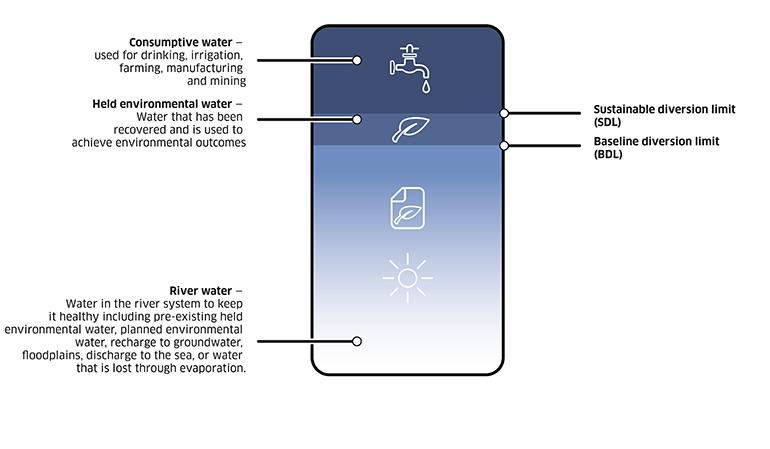Limits are in place for:
- individual water use – by an individual farmer or industry
- cumulative use – the sum of all collective water use in each management area.
Individual water use is limited by state allocation frameworks. These outline how much water can be used by an individual under their entitlement type or water allocation.
Total use is limited under the Basin Plan, through limits known as sustainable diversion limits. Each of the management areas in the Basin has its own limit on water use that Basin states and territories have to adhere to.
Key facts
Limits are set for 29 surface water areas and 80 groundwater areas across the Murray–Darling Basin.
There are limits that guide how much water can be used in each area of the Basin. These limits consider climate, trade, usage patterns and development of infrastructure.
Sustainable diversion limits are how much water, on average, can be used in the Basin by towns, communities, industry and farmers.
Baseline diversion limits are an estimate of how much water was used in the Basin, before the Basin Plan.
The current system of entitlements and allocations continues under local water use plans and rules.
The water recovery target is a specified number in the Basin Plan.
Individual limits
Water users are legally entitled to use all the water allocated to them by their state government.
The amount of water available to allocate changes from year to year and depends on storage levels and weather conditions.
Water usage patterns in the Basin are diverse. Usage year-to-year varies depending on climatic conditions, rainfall, trade, infrastructure development and individual business decisions.
Compliance with individual limits is measured by Basin state governments, using tools such as water meters.
Find out more about water entitlements and allocations.
Baseline diversion limits
Each management area also has a baseline diversion limit, which is an estimate of how much water was used in the Basin – or was allowed to be used - before the Basin Plan. Initial limits were established under the Basin Plan in 2012.
These estimates are available to read in the Baseline Diversion Limit reports.
Purpose of sustainable diversion limits
Sustainable diversion limits are how much water, on average, can be used in the Basin, while keeping the rivers and environment healthy.
Sustainable diversion limits are in place for 29 surface water areas to manage water use in different rivers, while limits are in place for 80 groundwater areas, to manage water under the earth’s surface. These limits come into effect from 2019 and are binding on all states in the Basin.
These limits are not enforced in real time. Basin state governments are the frontline of compliance and enforcement and are responsible for policing water use in their respective states in real time.
The MDBA assesses if water limits have been adhered to at the end of the water year. In our accounting we consider the:
- water available for use by each state
- water expected to be used by each state if it was at the limits (this is known as the permitted take)
- actual amount of water used by each state.
Our assessment is then provided to the Inspector-General of Water Compliance (IGWC) who considers this information along with any Basin State claim for reasonable excuse in determining compliance with the SDLs. The IGWC investigates any excess use to ensure use remains within the sustainable diversion limits.
While in each state there are different compliance rules and enforcement approaches, the IGWC oversees compliance and enforcement across the Basin. If a Basin State is found to be non-compliant with the SDLs, the Inspector-General may require that State to prepare an SDL Action Plan. For further information please refer to the IGWC's Sustainable Diversion Limit Compliance Framework October 2023.
Limits can change – all water managers need to consider the best available information for setting limits, and these may adjust as new information comes to hand.
Types of surface water in the Basin
Three different types of water are accounted for in the sustainable diversion limits system.

1. Consumptive water
Sustainable diversion limits focus on limiting consumptive water over the long term.
2. Held environmental water
Held environmental water (HEW) is water that has been recovered for the environment and is used to improve the health of our rivers, lakes, wetlands and aquifers. HEW includes all water recovered for the environment, including recovery under the Basin Plan, through Bridging the Gap programs, Efficiency Measures and Additional HEW acquisitions, and recovery prior to the Basin Plan.
3. River water
River water stays in the river system or is lost through evaporation and seepage. In groundwater, system water stays within the aquifer to maintain aquifer functions and health.
Evaporation rates in the Basin are high, with 94% of the rainfall in the Basin being used by plants (transpired) or evaporating from the land and surface water.
Last updated: 2 August 2024